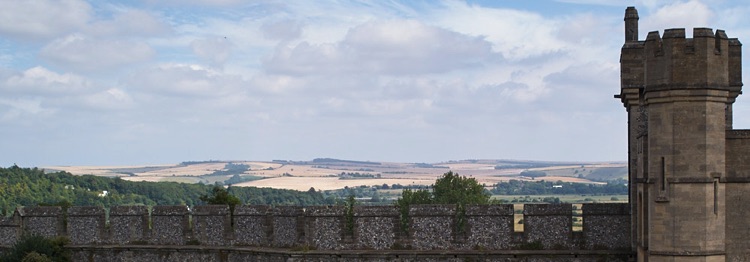
Highlights
Three medieval town gates
St Martins church
Medieval cellars are privately owned, but tours sometimes offered
Ruins of Greyfriars monastery is on private land and not accessible
Town Museum
Visitor Information
Street parking available near St Martins
Refreshments at the New Inn pub; sandwiches at the village shop
Public bathrooms available
History
Old Winchelsea
Old Winchelsea grew on a low shingle bank under what is now the estuary of the river Rother. While the geography of the estuary has changed significantly over the years, the area has always provided a large, safe anchorage for ships. This enabled the development of the town of Winchelsea and its eventual membership in the Confederation of Cinque Ports. Winchelsea has seen its share of history and I have highlighted some events that have touched Winchelsea below.
1215
Towards the end of the barons rebellion, Prince Louis of France - the rebel leader, was driven to Winchelsea where he was hoping for rescue by a French fleet. Unfortunately for Louis, the Masters of the Cinque Ports were by now holding Rye and Winchelsea for the king and Louis was not able to escape. He entered Winchelsea, but the townspeople aware Louis was coming and abandoned the town, taking all food and supplies with them. This left Louis in a precarious position and he had to rescued by a French relief force allowed to ride down from London.
1242
The king of France prepared for an invasion of England and assembled a fleet to transport 4,000 knights and 1,000 carts across the channel. King Henry declared war on France and ordered the masters of the Cinque ports to be on guard for and to resist any French aggression. In a somewhat loose translation of this order, the Masters of the Cinque ports took the opportunity to raid and pillage French ships. A year later the Cinque ports had to seek assistance from the Archbishop of York after three French raids in quick succession.
1250
Always in a precarious position with regard the sea, a series of violent storms hit Winchelsea causing much damage. In one October storm 300 homes and various bridges, mills and churches were flooded by the sea. More severe storms followed in 1252 and many more houses and people in Winchelsea were lost to the sea.
1254
There was often fierce competition between the Cinque Ports, which had special royal privileges, and other ports. In 1254 the people of Winchelsea had prepared some ships for Queen Eleanor's visit to the continent. At the same time some ships prepared for Prince Edward (later Edward I) by the people of Yarmouth docked at Winchelsea. The people of Winchelsea were distressed to find the ships they had prepared for the Queen were smaller and less well appointed than those of the Prince. In a misguided attempt to rectify this situation the people of Winchelsea destroyed and damaged the Yarmouth ships and used one the masts from Yarmouth on one of their own ships. The people of Yarmouth complained vigorously to the Masters of the Cinque ports and the situation was only placated by the intervention of Queen Eleanor herself.
1283
In 1283 with the progressive encroachment of the sea on Old Winchelsea, Edward I commissioned the construction New Winchelsea on higher ground. Unlike older medieval towns that had grown organically, Edward’s new towns had wide (for medieval times), straight streets, and usually well fortified walls. While all of Old Winchelsea is now lost, the original street patterns of new Winchelsea are still present and there are a number of buildings in Winchelsea that date from this period. St Thomas church is an example of one of the original buildings from this period. There are also over fifty medieval cellars surviving. These were thought to be used in the thriving Winchelsea wine trade of the thirteenth and fourteenth centuries.Two monasteries were built in the Winchelsea. One in 1285 by the Franciscan order, known as the “Greyfriars”. Some ruins of this building remain. It is on private property, but there are occasional events that are open to the public. The other monastery at Winchelsea was built by the Dominicans, known as the “Blackfriars”.
Edward commissioned a number of new towns during his reign, most of them to help with his colonial ambition in Wales. It’s more likely Winchelsea new town was built to help protect the ship building capacity of the Cinque Ports.
1295
Edward I issued a commission of array. His sheriffs from Hampshire, Dorset, and Wiltshire were ordered to muster three thousand armed men and to report to the fleet at Winchelsea.
1350
A sea battle took place just off the Winchelsea coast between King Edward III and a Spanish fleet. Queen Philippa stayed at the Greyfriars monastery in Winchelsea when Edward put sea with his fleet. She is reported to have climbed a nearby hill and observed the battle first hand.
Winchelsea
Gallery
Map
Website



